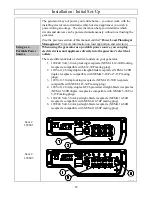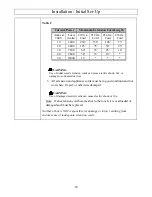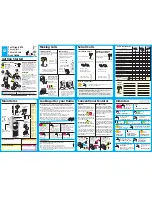
Operation
29
WARNING
:
Gasoline fire/explosion hazard
Gasoline is highly flammable and explosive. Heat, sparks, and flames can
ignite gasoline vapors, which can become widespread during fueling. A
flash fire and/or explosion could result and cause serious injury or death.
Use extreme care when handling gasoline. Carefully follow all the
instructions in this section to avoid the following conditions which could
result in gasoline ignition:
gas vapor collection inside enclosures
static electric sparks
sparks from electric wiring, batteries, or running engines
sources of heat (such as a hot engine or exhaust)
open flames, including pilot lights
1) Before starting, review the following general safety precautions for fueling:
a) Never pump gasoline directly into the generator’s gas tank at a gas station –
high velocity flow from the pump could result in a static electric build-up
in the generator’s tank. Always use a portable container to fill the tank.
See warning box about static electric spark hazards below.
b) Fill gasoline tank OUTDOORS – never indoors.
c) Stay away from all sources of heat, sparks, and flames. Do not smoke.
2) Turn generator engine off and allow to cool for at least two minutes before
removing gas cap.
Note: A running or still-hot engine is hot enough to ignite fuel.
3) Remove generator gasoline cap.
4) Add gasoline through the fill opening:
- Use only an UL-approved portable gasoline container to transfer the gasoline
to the generator’s tank. Follow the safety warning and instructions below for
avoiding static electric sparking.
- Do NOT overfill the gasoline tank. Fill to bottom of fill neck to allow for
fuel expansion.
WARNING: Static electric spark hazard
A static electric spark can explosively ignite gasoline vapor, resulting in a
flash fire that could cause serious injury or death.
To avoid static electric sparking while filling the gasoline tank,
the
following steps must be followed to minimize and safely dissipate static
electric charge build-up before and during the fueling process
:
Always dissipate static charge from your body before beginning the
fueling process by touching a grounded metal object at a safe distance
from fuel sources.
Never fill the generator’s gas tank directly from the fuel pump – the
generator’s tank is not grounded and high velocity flow from the pump
can cause static electricity build-up. Use an approved portable
container to transfer gas to the generator’s tank.
Summary of Contents for 165601
Page 2: ...Hazard Signal Word Definitions 2 ...
Page 43: ...Generator Exploded View Rev O 3 Item s 165601 165603 165604 43 ...
Page 45: ...Generator Exploded View Rev O 3 Item s 165605 165606 165607 45 ...
Page 47: ...Control Panel Parts List Rev O 3 47 Item 165601 Item 165603 Item 165604 ...
Page 48: ...Control Panel Parts List Rev O 3 48 Item 165605 Item 165606 Item 165607 ...
Page 50: ...Generator Head Exploded Views Rev O 3 Item s 165601 165603 165604 165605 50 ...
Page 52: ...Generator Head Exploded Views Rev O 3 Item s 165606 165607 52 ...
Page 54: ...54 This page has intentionally been left blank ...
Page 56: ...56 Assembled by Northern Tool Equipment Company Inc Burnsville MN 55306 NorthernTool com ...
















































